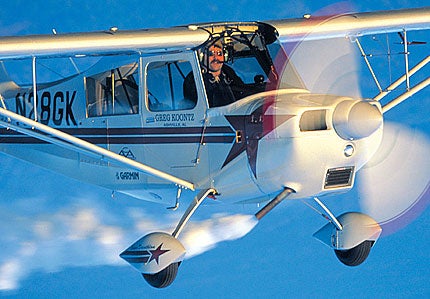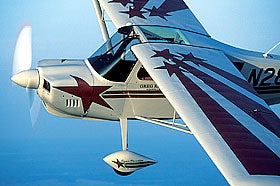 For every high-profile air-show act, like Patty Wagstaff or Sean Tucker, there are dozens of pilots scattered around the country who dream the dream. But few have pursued that dream as relentlessly as Alabaman Greg Koontz has.
For every high-profile air-show act, like Patty Wagstaff or Sean Tucker, there are dozens of pilots scattered around the country who dream the dream. But few have pursued that dream as relentlessly as Alabaman Greg Koontz has.
"I was seven years old when my dad took me to see my first air show," says Koontz. "Bevo Howard was flying his Bucker Jungmeister that came over on the Hindenburg, Hal Krier was in his Krierkraft biplane, and Dick Schram was performing as the ’flying professor' in a Cub comedy act. They're some of the greatest air-show pilots who ever lived. When it was over, I told my dad, ’I'm going to be an air-show pilot, too.' And that thought has never left my head. Not for a single minute."
"I've never expected to attain superstar status," he continues. "But I had to be doing it. I had to be out there, living the life. Even though I strayed from ’the path' for a few years, in my heart, I never saw myself as being anything other than an air-show pilot."
Koontz is a son of the South, having been born in North Carolina and raised in Birmingham, Ala. His dad hustled around three-piece suits in Twin Beeches and eventually a Hawker 125 and was always thinking about his son's air-show urges.
Koontz remembers, "He was on a trip down to St. Augustine, Fla., and when he returned, told me Ernie Moser, who ran Aero Sport, a largely sport-aviation FBO, had a Cub for sale. I was 19 or 20 at the time. I scrounged up a down payment and bought the Cub, but I had barely made it home with it when Ernie Moser called and said they needed the Cub for their air show and didn't really mean to sell it."
The late Ernie Moser was one of the very early practitioners of a form of air-show act that was more flying circus than anything else. He would bundle a bunch of air-show acts together and offer them to air-show promoters as a ready-to-go show.
Apparently, Moser hadn't planned ahead and found he needed Koontz's Cub for the comedy/flying farmer act and for the world's shortest runway act, where it was landed on a platform on top of a moving truck. This was exactly the kind of opening Koontz had been waiting for.
"I'm no dummy. They wanted my Cub. I wanted to be an air-show pilot. The rest was obvious. I said I'd bring the Cub down, but I was going to be the one flying it," he grins. "Ernie said I could do the comedy act, so I spent months learning to do crazy things with a Cub down low. My first show was in Decatur, Ala., and I was the happiest 20-year-old on the planet."
"A year later," continues Koontz, "Ernie hired me full time and I was doing aerobatic instruction at Aero Sport in addition to the air-show stuff. Ernie taught me the Cub-on-a-truck act, the rope ladder transfer and about everything having to do with the Cub."
Every entertainer wants to move up and so did Koontz. "I wanted to start doing aerobatic acts, but everyone at Aero Sport was already an aerobatic pilot and they had no need for me," Koontz continues. "Then Jim Moser [Ernie Moser's son] bought a Jungmann and they let me start doing the Citabria act. I'd be so high, you could barely tell what kind of airplane it was, but at least I was flying aerobatics at air shows, and that was a big deal to me."
Bellanca, which was called American Champion then, manufacturers of the Citabria, recognized the limitations of the old flatwing Champ cum Citabria. It could do so-so inside aerobatics, but its wing was at a serious disadvantage upside down. The airplane needed a symmetrical wing and it got it when the company brought out the Decathlon.
"Being a dealer, Aero Sport got one of the first 150-hp Decathlons, and I thought I was in hog heaven when they let me start flying it in air shows. I could actually do outside loops and some of the other stuff a Citabria couldn't even think about doing. Now I felt like I was an air-show pilot, and when the 180-hp Super Decathlon came out, I was really living my dream."
 |
| A 150-pound increase in useful load and the elimination of theexternal hydraulic brake line gives the latest generation of Decathlons better balance in all areas, making it an excellent aerobatic airplane. |
There comes a time in everyone's life when the dream sometimes steps sideways for a short period while some of the more mundane aspects of life take over.
"At some point, it was as if I felt I needed to grow up or something. I can't exactly explain it, but I must've decided I needed to go buy one of those mortgage things, have a couple of kids and a dog in the front yard. The air-show business isn't known for its stability, so I turned in my air-show wings and left St. Augustine to fly Navajos in a corporate environment," explains Koontz.
With the regular income, Koontz decided he, at the very least, had to have an aerobatic airplane. So in 1993, he bought a brand-new Super Decathlon. "I was teaching aerobatics on the side and did maybe six or seven shows a year. At the same time, the corporate flying kept growing, and pretty soon, I was flying around in Lears and King Airs, but I wasn't having much fun."
Eventually, what was an annoying itch in Koontz's psyche became a major irritation. "The corporate job was getting bigger and bigger, and I was getting older and older, and I just wasn't doing what I wanted to do. So, my wife and I talked it over and bought a place on a grass strip out in the country, and I quit my job to go full time in aerobatics and air shows. Some of our saner friends say I've gone off to join the circus, and I tell them they're right and I'm loving it."
"Almost as soon as I went full time, American Champion called and said something to the effect of ’We can't have you out there flying a 10-year-old airplane,'" continues Koontz. "’Why don't you fly for us in a brand-new one?' I didn't have to think too long before I said yes."
The airplane that Koontz is currently campaigning under the American Champion banner is the latest Super Decathlon. "This is one of the first airplanes with the big baggage door on the side as well as the MT composite constant-speed prop," says Koontz. "The prop is lighter, accelerates great and reduces airframe vibration. It's much smoother. This airplane is also the first Super Decathlon with the new aluminum landing gear. It gives a 150-pound increase in useful load and eliminates the external hydraulic brake line because it's gun-drilled. In general, this generation of Decathlons is much better balanced in all areas and is actually a really good aerobatic machine. The older airplanes were okay, but this one is a gigantic leap forward, and a person familiar with the old ones really has to fly this one to see the difference. American Champion turned its focus on its Super Decathlon and have come up with just what it needed to be very competitive."
As this was being written, Koontz had moved his aerobatic and flight-training business out to Dugger Field, a beautiful grass field 10 miles southwest of Gadsden, Ala., where he'll live full time as soon as his house is finished. When he's not flying air shows, he's directly over the airport in his own aerobatic box, teaching people from all over the country the finer arts of old-fashioned, stick-and-rudder aviating, including aerobatics and emergency maneuver training.
Koontz says, "This is what I was meant to do my entire life. I love air-show flying and I love this kind of flight training. I just don't know how much better I could have it." Frankly, Koontz, we're jealous.

Subscribe to Our Newsletter
Get the latest Plane & Pilot Magazine stories delivered directly to your inbox





